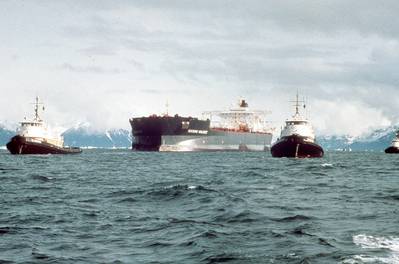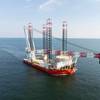Back to the Drawing Board: The Worst Ship in History – Exxon Valdez
While Greg Trauthwein never assigns me column subjects, each time the Great Ships issue comes around I go with the theme. However, I try to take a view askew on that subject and have found that these are the rare columns where I am criticized for my views. Greg must enjoy that, and this year he asked me to write a column on the worst ship designs. That was the entire assignment, and it was unclear if he asked me to discuss the worst ship designs for 2023, or in the history of ship design. Oddly if I assumed it to be for 2023, there was a very short list and a clear winner; the Titan submersible, but that has been discussed in a prior column. If one assumed the assignment to cover all of ship design history, the choice becomes more difficult.
In the course of history what does bad design mean?
In pondering that I discovered that many designs that are touted as bad designs, in actual fact, are not bad designs. Instead, they were ships that were unlucky or were innovative approaches that did not work out.
When an innovative ship design does not work out, it is more likely that the actual failure was related to a lack of will by the actual vessel operators to try a little harder, or from unfounded badmouthing by competitors. Most of all, true innovators (not mindless curb side promotors) should get the benefit of the doubt. Innovation is hard, really hard.
Sometimes a design fails because of a design mistake. That is unfortunate, but we are all human and mistakes get made. To call a design bad because of a mistake is easy to do, but not terribly illustrative of bad design.
I came to realize that a bad design has to be bad from the first moment of conception. I can think of other more recent less well-known recent examples too, but none is as obvious as the Exxon Valdez. When the TAPS (Trans Alaska Pipeline System) trade started opening, the Carter Administration indicated that all TAPS tankers should have double bottoms for safety and environmental reasons. This compelled the first generation of TAPS trade ship operators to build a number of double bottom Jones Act crude oil tankers. However, during the Reagan administration, the double bottom requirement was no longer discussed and never enacted, and that left the field open for construction of new single skin TAPS tankers. And Exxon decided to build the single skin Exxon Valdez and Exxon Long Beach. hat was perfectly legal, but resulted in the weird irony of older double bottom tankers operating alongside newer single skin tankers in the TAPS trade.
Double bottom tankers were a little more expensive to build (at the time I estimated 5%), but this is balanced against substantially lower operating costs, which had already been proven with the operation of the older TAPS tankers.
The Exxon Valdez was designed and built in the middle 1980’s, despite the fact that that double bottom tankers had been discussed and built since the middle 1970’s and that oil pollution was a central concern for the TAPS trade.
Instead of simply copying the older double bottom tanker designs (but with diesel engines instead of steam plants), somebody, somewhere, must have said: No Boys, let’s not do that, let’s make a new design that reaches back to prior inferior designs. A double bottom tanker costs no more over its lifetime, but, hey, why bother with something that reduces the risk of oil spills if nobody makes you do it? So unnecessary design money was spent to create the Exxon Valdez and, as they say, the rest is history.
Whatever the reason, somewhere out there a designer put pencil to paper and nobody ever said: What the hell is going on here? And created, what I consider to be, the worst ship design in history.
Right after the Exxon Valdez disaster, I was asked to perform a study and determine how much less oil would have been spilled if the Exxon Valdez had been designed with a double bottom. I estimated about 50% less oil would have been spilled. I was mercilessly grilled in deposition by opposing attorneys and their experts fiercely argued against my findings. However, later studies showed I was dead on, not because I was particularly brilliant, but because I was young and afraid of embarrassing myself. Therefore, I meticulously stuck to real analysis.
The older opposing experts fiercely expounded on the advantages of single skins, but, as per the Max Planck Maxim, are now mostly dead, and nobody any longer argues that single skin tankers are better. And double hull tankers are much better than anybody could have even imagined! We know, because oil spills from tanker hull breaches have been virtually eliminated.
But here comes the irony. If the Exxon Valdez had been built with a double bottom, there still would have been a very bad oil spill in Prince William Sound, which I personally believe, on a nice day, is the most beautiful place in the world. There still would have been a massive uproar, but would anybody have suggested that all single skin tankers need to be retired and all new tankers should be double hull?
One can imagine the comments of the doyens: Well, here is proof that double bottoms don’t work, we might as well keep building single skin tankers.
Is it possible that the worst ship design in history actually, singlehandedly, eliminated oil pollution from tanker hull breaches?
For each column I write, MREN has agreed to make a small donation to an organization of my choice. For this column I will donate the money to myself and buy a bottle of extremely nice Scotch. I will leave it in my office and whenever a ship designer or engineer visits me, I will share a dram with her and toast to Capt. Hazelwood’s memory. Capt. Hazelwood was a very capable ship captain, and his drinking problem had absolutely nothing to do with the Exxon Valdez spill. At worst he made a mistake, and he was unfairly vilified for it. We all make mistakes, but choosing a bad design over a good design is not a mistake.













